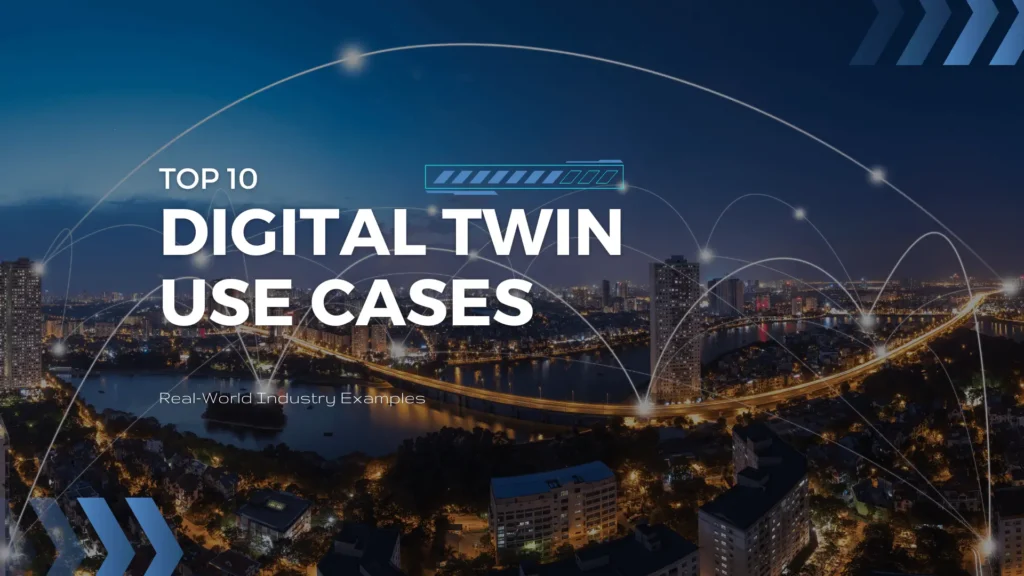
As more industries move into the digital world, one technology is helping them improve – digital twins. But what exactly is a digital twin? Simply put, a digital twin is a virtual copy of a real object, system, or process. It uses data from the real world to help businesses make better decisions, run more smoothly, and even predict future problems.
In this blog, I’ll explain the top 10 digital twin real-world use cases of how industries are using digital twins to stay ahead, save money, and innovate.
1. Manufacturing: Making Factories Work Better with Digital Twins
How do digital twins help in manufacturing?
In factories, digital twins make things run more efficiently. By creating digital copies of machines, manufacturers can keep an eye on equipment, predict when repairs are needed, and improve production lines.
For example, Siemens uses digital twins to monitor factory machines, stopping costly repairs by predicting problems early.
2. Healthcare: Customizing Patient Treatment with Digital Twins
How do digital twins change healthcare?
In healthcare, digital twins are helping doctors create personalized treatment plans for patients. Doctors can use digital twins to model organs, simulate surgeries, and predict how a patient will respond to different treatments.
For instance, Philips uses digital twins to help doctors plan surgeries and monitor devices like pacemakers.
3. Aerospace: Making Planes Safer with Digital Twins
How do digital twins improve the aerospace industry?
In aerospace, digital twins are used to create digital versions of aeroplane parts, such as jet engines. Engineers can test designs and predict maintenance needs before any problems happen.
Boeing uses digital twins to test plane designs, preventing costly mistakes. They also monitor planes in real time to avoid engine failures.
4. Automotive: Building Better Cars with Digital Twins
How do digital twins help in the automotive industry?
In the car industry, digital twins help manufacturers test designs before building cars. They make sure vehicles are safe, fuel-efficient, and ready for production.
Tesla uses digital twins to monitor cars after they are sold, allowing for software updates to be done remotely.
5. Energy and Utilities: Improving Power Plants with Digital Twins
How do digital twins help in the energy sector?
Energy companies use digital twins to monitor power grids, predict when equipment will fail, and reduce energy use. This helps power plants run more efficiently and become more sustainable.
For example, BP uses digital twins to monitor its oil platforms, saving energy and reducing their environmental impact.
6. Smart Cities: Making Cities Smarter with Digital Twins
How do digital twins benefit city planning?
In urban planning, digital twins are used to help cities manage traffic, water, and other resources. Singapore uses a digital twin of the entire city to improve traffic flow, manage energy, and keep the city running smoothly.
7. Retail: Enhancing Customer Experience and Managing Inventory
How do digital twins help retailers?
Retailers use digital twins to create virtual versions of their stores. This helps them test store layouts, predict customer behaviour, and manage inventory.
Walmart uses digital twins to ensure they have the right amount of stock to meet customer demand.
8. Agriculture: Making Farming Smarter with Digital Twins
How do digital twins help in agriculture?
Farmers use digital twins to monitor crops, weather, and soil. This allows them to optimize irrigation, reduce pesticide use, and increase crop yields.
John Deere uses digital twins to monitor farming equipment, helping farmers maintain their machinery and keep operations running smoothly.
9. Construction: Improving Building Design and Safety
How do digital twins benefit construction?
In construction, digital twins help architects and engineers design safer buildings and monitor construction projects in real-time. They help detect potential problems early so projects stay on track.
Skanska uses digital twins to track building progress, helping them finish projects on time.
10. Logistics and Supply Chain: Making Deliveries Faster and Cheaper
How do digital twins improve logistics and supply chains?
Logistics companies use digital twins to track shipments in real-time, optimize warehouse operations, and avoid delivery delays.
DHL uses digital twins to predict potential bottlenecks, rerouting shipments to ensure fast deliveries.
Conclusion: The Future of Digital Twins Across Industries
Digital twins are changing the way industries work—from manufacturing and healthcare to smart cities and energy. As digital twin technology continues to improve, we can expect even better results with real-time optimization and smarter predictions.
If your business hasn’t explored digital twins yet, now might be the time to do so. Whether you’re in energy, retail, or agriculture, adopting digital twins can help you stay ahead of the competition and drive innovation.
